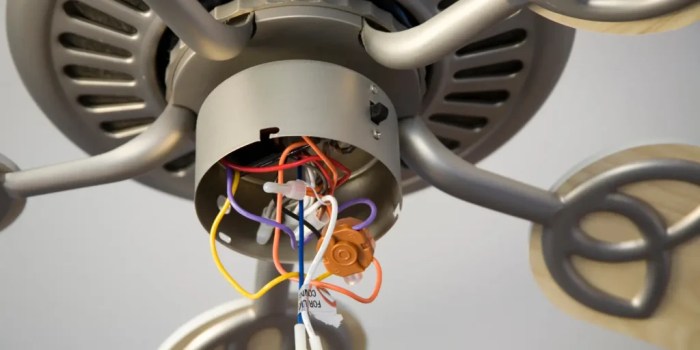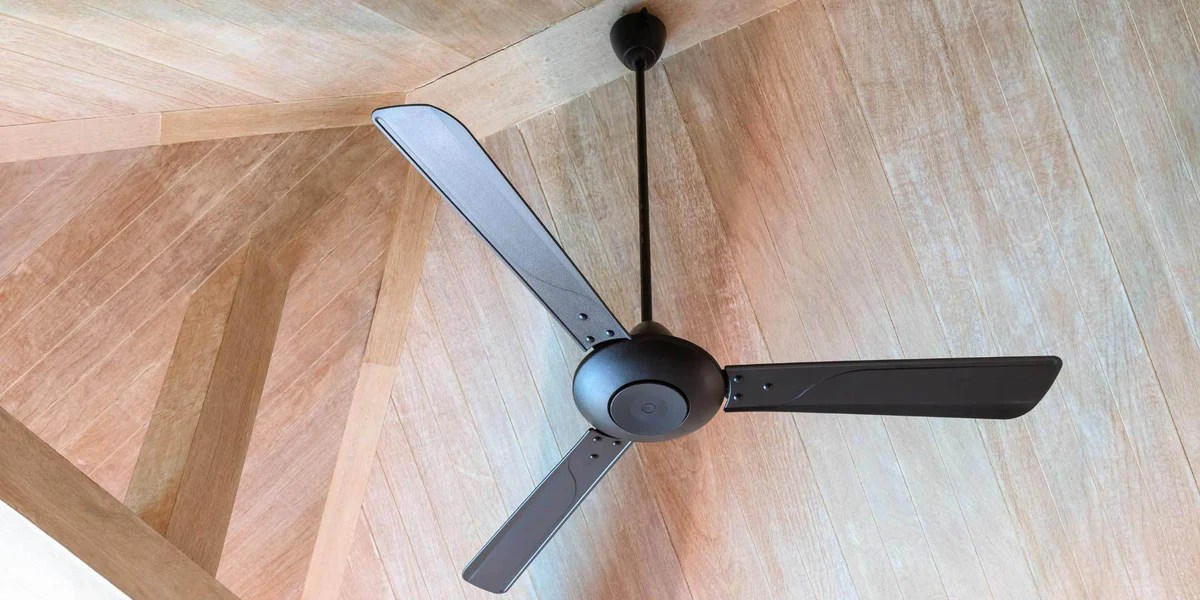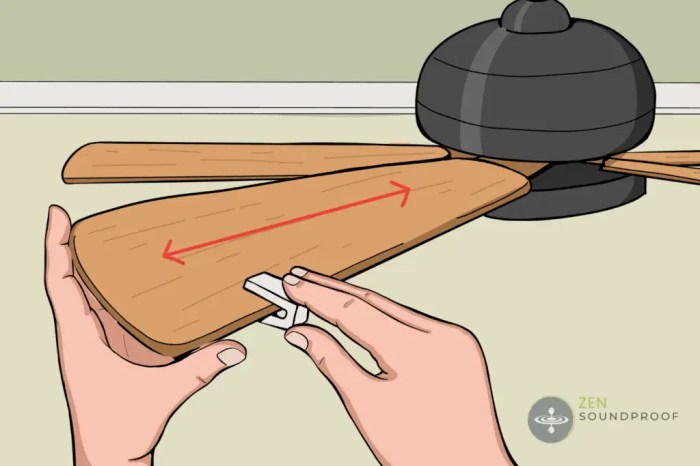A ceiling fan, a seemingly simple appliance, can unexpectedly become a source of frustration. From a persistent wobble to a complete refusal to turn, these common malfunctions can disrupt comfort and even pose safety risks. This guide delves into eight frequent ceiling fan issues, providing clear explanations, troubleshooting steps, and preventative maintenance advice to help you restore smooth, silent operation.
Understanding the underlying causes of these problems is key to effective repair. We’ll explore symptoms, likely culprits, and potential damage, equipping you with the knowledge to diagnose and resolve most issues yourself, saving you time and money. Whether your fan is wobbling, making strange noises, or simply refusing to start, this comprehensive guide offers practical solutions and valuable insights.
Identifying Common Ceiling Fan Problems

Ceiling fans, while seemingly simple appliances, can develop a range of issues. Understanding these problems and their causes can save you time, money, and frustration. This section details eight common problems, their symptoms, likely causes, and potential consequences. Early identification and addressing these issues can prevent further damage and ensure your fan continues to provide efficient and comfortable air circulation.
Common Ceiling Fan Problems and Their Causes
A variety of factors can contribute to ceiling fan malfunctions. These range from simple fixes like a loose connection to more complex problems requiring professional attention. Understanding the symptoms associated with each issue is crucial for effective troubleshooting. The following table summarizes the most frequent problems encountered.
| Problem | Symptoms | Likely Causes | Potential Damage |
|---|---|---|---|
| Fan Doesn’t Turn On | No movement of blades, no sound. | Power outage, blown fuse/breaker, faulty wall switch, loose wiring, bad capacitor, broken motor. | Minimal damage if a simple fix (like a tripped breaker); potential motor damage if the issue is internal. |
| Fan Wobbles or Shakes | Excessive vibration, rattling noise, blades hitting the ceiling or light kit. | Uneven blade length or balance, loose blades, bent blade, unbalanced motor, loose mounting hardware. | Minor damage initially, but continued operation can lead to blade breakage, motor damage, and even ceiling damage. |
| Fan Makes Noise | Clicking, humming, grinding, or whining sounds. | Loose screws or parts, worn bearings, rubbing blades, motor problems. | Minor to moderate damage depending on the cause; can lead to motor failure if ignored. |
| Fan Runs Slow | Blades rotate slowly, even on high speed. | Low voltage, faulty capacitor, worn motor brushes, clogged motor, dirty blades. | Minimal damage if the cause is easily rectified; prolonged slow operation can strain the motor. |
| Fan Runs Erratically | Fluctuating speeds, intermittent stopping and starting. | Faulty capacitor, loose wiring, problems with the speed control switch, motor issues. | Potential motor damage due to inconsistent power supply; could lead to premature failure. |
| Fan Only Runs in One Direction | Unable to switch between forward and reverse. | Faulty switch, broken wiring in the switch, loose connection, issues within the motor reversing mechanism. | No significant damage, but limits the fan’s functionality; replacing the switch is usually the solution. |
| Light Fixture Doesn’t Work (If Applicable) | Light doesn’t turn on. | Blown bulb, faulty wiring in the light fixture, bad switch, problems with the light kit itself. | Minimal damage if it’s just a burnt-out bulb; more serious if wiring or the light kit is faulty. |
| Flickering Light (If Applicable) | Light flickers intermittently. | Loose wiring, faulty bulb, poor connection, problems with the light kit’s electrical components. | Potential for electrical fire if the issue is not addressed; can also damage the light fixture. |
Troubleshooting Techniques for Each Problem

Addressing common ceiling fan issues effectively requires a systematic approach. This section details troubleshooting steps for several prevalent problems, enabling you to identify and resolve them efficiently, minimizing the need for professional assistance. Understanding the underlying causes will help you prevent future occurrences.
Wobbling Ceiling Fan Troubleshooting
A wobbling ceiling fan is not only annoying but can also lead to premature wear and tear. The wobble usually originates from an imbalance in the fan blades. The following steps Artikel a methodical approach to rectifying this issue.
- Inspect the Blades: Carefully examine each blade for any damage, such as cracks or bends. Replace any damaged blades immediately.
- Check Blade Tightness: Ensure all blades are securely fastened to the motor housing. Tighten any loose screws using a screwdriver. A slightly loose blade can create significant wobble.
- Balance the Blades: If the blades appear undamaged and securely fastened, the problem likely stems from an imbalance. Use a balancing kit (available at most hardware stores) or a DIY method involving small pieces of tape strategically placed on the blades’ trailing edges to achieve balance. Start with small pieces and test the fan after each addition.
- Check the Motor Mount: If the wobble persists after balancing the blades, inspect the motor mount for any looseness or damage. If the mount is loose, tighten it securely. If it’s damaged, replacement may be necessary.
Ceiling Fan Won’t Turn On Troubleshooting
A ceiling fan that refuses to operate can have several causes, ranging from simple power issues to more complex electrical problems. Addressing these systematically increases your chances of a quick fix.
- Check the Circuit Breaker: The most common cause is a tripped circuit breaker. Check your home’s breaker box for a tripped breaker related to the fan’s circuit. Reset the breaker if it’s tripped.
- Verify Power to the Fan: Use a voltage tester to confirm that power is reaching the fan’s wiring. If no power is present, the problem lies within the house wiring and may require professional assistance.
- Examine the Wall Switch: Ensure the wall switch controlling the fan is in the “on” position. Test the switch with another device to rule out a faulty switch.
- Inspect the Wiring Connections: Carefully check all wiring connections at the fan and in the junction box for any loose or damaged wires. Tighten any loose connections and repair or replace damaged wires as needed. This often requires turning off the power at the breaker box for safety.
- Check the Pull Chains: If the fan has pull chains, ensure they are properly engaged and not damaged. Sometimes, the chains can become dislodged or broken, preventing the fan from operating.
- Test the Capacitor (if applicable): A faulty capacitor can prevent the fan motor from starting. This will be discussed in a later section.
Unusual Ceiling Fan Noises Troubleshooting
Unusual noises from your ceiling fan often indicate a problem requiring attention. A flowchart helps systematically diagnose the source of the noise.
Flowchart for Troubleshooting Unusual Ceiling Fan Noises:
Start → Is the noise a clicking sound? → Yes: Check wiring connections and capacitor. No: → Is the noise a grinding or rubbing sound? → Yes: Check for blade contact with housing or other components. No: → Is the noise a humming or buzzing sound? → Yes: Check motor for potential issues (may require professional help). No: → Is the noise a rattling sound? → Yes: Check for loose screws or parts. No: → Investigate further (professional help may be needed).
Troubleshooting Methods Summary
A concise summary of troubleshooting methods for each problem facilitates quick reference.
- Wobbling Fan: Inspect blades for damage, check blade tightness, balance blades, and check motor mount.
- Fan Won’t Turn On: Check circuit breaker, verify power to fan, examine wall switch, inspect wiring connections, and check pull chains.
- Unusual Noises: Follow the flowchart above to systematically diagnose the cause of the noise.
- Fan Running Too Slowly: Check the capacitor (detailed below).
Checking the Capacitor for a Slow-Running Fan
A capacitor is a critical component in many ceiling fan motors, helping to start and regulate the motor’s speed. A faulty capacitor can result in a slow-running fan. Checking the capacitor requires caution due to the potential for electrical shock. Always disconnect power to the fan at the breaker box before performing any checks.
Capacitor testing usually involves using a multimeter set to measure capacitance. The specific procedure and expected capacitance values will vary depending on the capacitor’s rating, which is typically printed on the capacitor itself. If the measured capacitance significantly deviates from the rated value, the capacitor should be replaced with a new one of the same rating. Incorrect capacitor replacement can damage the fan motor. If you are not comfortable working with electricity, it’s best to seek professional assistance.
Safety Precautions and Preventative Maintenance

Ceiling fan repair, while often manageable for DIY enthusiasts, presents inherent safety risks if not approached cautiously. Understanding these risks and implementing preventative maintenance are crucial for ensuring both the longevity of your fan and your personal safety. Neglecting these aspects can lead to serious injury or even property damage.
Prioritizing safety should always be paramount. Working with electricity requires a meticulous and responsible approach. Even seemingly minor repairs can result in significant consequences if proper precautions aren’t taken. Regular preventative maintenance not only extends the lifespan of your ceiling fan but also significantly reduces the likelihood of encountering problems that might necessitate more complex (and potentially dangerous) repairs.
Power Disconnection
Before attempting any repairs or maintenance on your ceiling fan, always disconnect the power supply. This is the single most important safety precaution. Failure to do so could result in electric shock, potentially leading to serious injury or even death. Locate the circuit breaker controlling the fan’s power and switch it to the “off” position. Visually confirm the power is off by using a non-contact voltage tester to check the wires at the fan’s connection points. This simple step dramatically reduces the risk of accidental electrocution.
Potential Safety Hazards
Working at heights presents risks. Ceiling fans are typically installed at significant heights, requiring the use of a stable ladder or step stool. Ensure the ladder is properly positioned and secured before commencing work. Never overreach while on a ladder, and always maintain three points of contact (two hands and one foot, or two feet and one hand). Falling from a height can cause serious injuries. Furthermore, loose or damaged fan blades pose a significant risk of injury. Inspect the blades carefully for cracks, chips, or wobbles before and during any maintenance. Sharp edges or unbalanced blades can cause serious injury if the fan is operated.
Preventative Maintenance Checklist
Regular preventative maintenance is key to avoiding common ceiling fan problems. A simple checklist can help you stay on track and ensure your fan operates safely and efficiently.
- Visual Inspection: Check for loose screws, damaged blades, or any signs of wear and tear on a monthly basis.
- Blade Tightening: Tighten all screws securing the blades to the motor housing at least twice a year. Loose screws can lead to wobbling and eventual damage.
- Lubrication: Lubricate the motor bearings annually using a light oil specifically designed for motors. Refer to your fan’s manual for specific recommendations.
- Cleaning: Dust and debris accumulation can affect performance and create an imbalance. Clean the blades and motor housing with a soft cloth and mild detergent at least every three months. For difficult to reach areas, a feather duster or compressed air can be helpful.
- Wiring Inspection: Once a year, inspect the wiring connections for any signs of damage or loose connections. If you are not comfortable with electrical work, consult a qualified electrician.
- Balance Check: Annually, check for blade imbalance. A wobbling fan can indicate an imbalance and should be addressed immediately. Small weights can sometimes be added to balance the blades.
Using a Multimeter for Electrical Diagnostics
A multimeter is an invaluable tool for diagnosing electrical problems in your ceiling fan. It allows for precise measurement of voltage, current, and resistance, helping to pinpoint the source of electrical issues. For example, a multimeter can determine if power is reaching the fan motor, identify a short circuit, or test the integrity of the capacitor. While not essential for all repairs, a multimeter provides a more accurate and efficient diagnostic approach, minimizing the risk of further damage. Understanding how to safely and correctly use a multimeter is crucial for anyone undertaking electrical repairs. However, if you are uncomfortable using a multimeter, it’s always best to consult a qualified electrician.
Final Conclusion

Successfully diagnosing and resolving ceiling fan problems empowers you to maintain a comfortable and safe home environment. By understanding the common issues, implementing effective troubleshooting techniques, and performing regular preventative maintenance, you can significantly extend the lifespan of your fan and avoid costly repairs. Remember safety is paramount; always disconnect power before undertaking any repairs. With the knowledge gained from this guide, you’re now well-equipped to tackle most ceiling fan challenges with confidence.